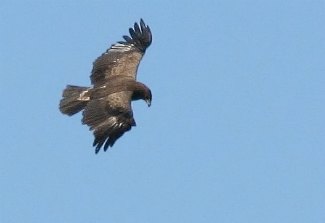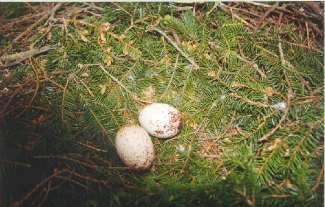Lesser Spotted Eagle - Aquila pomarina
By Drägüs, Public domain, via Wikimedia Commons
Family: Accipitridae
Genus: Aquila
Species: A. pomarina
Lesser Spotted Eagles are brown, medium-sized raptors that breed in Europe and winter in eastern and southeastern Africa. Aquila hastata (Indian Spotted Eagle) was formerly considered a subspecies of Aquila pomarina, but based on morphological, osteological, reproductive, and behavioral differences between the two, it is now considered a separate species.
Physical Description:
Lesser Spotted Eagles are brown from above, except for a light-colored head and neck and pale upperwing coverts. They have a small white patch on the primary feathers and the flight feathers are dark brown to black. The wings are broad. The eyes, cere, and feet are yellow, and they have a small bill. The legs are densely feathered, which makes them look long and relatively thin for their size.
They resemble and may be confused with Aquila clanga (Greater Spotted Eagle) and Aquila nipalensis (Steppe Eagle). Their shape is closest to A. clanga, but that species is larger with a bigger head and bill, longer wings, and shorter tail in relation to its body length. There is also no obvious contrast between the flight feathers and wing coverts, which visible in Lesser Spotted Eagles. A. nipalensis is also larger than A. pomarina and has a pale throat and darker underbody, in addition to heavier barring.
Juveniles are darker than adults. They have a rufous patch on the nape of the neck, and the wing coverts, trailing edge of the wings, and the tail are tipped with white. They mature and reach full adult plumage after 3-4 years.
Lesser Spotted Eagle calls are short, high-pitched piping whistles. Listen to a recording.
Their maximum lifespan is 26 years. However, the average in the wild is only 8-10 due to a mortality rate of 35% for juveniles, 20% for immatures, and 5% for adults.
Size:
Length: 55-65 cm
Wingspan: 143-168 cm
Weight: 1.2-2.6 kg
By Artur Mikołajewski, CC-BY-SA-3.0, via Wikimedia Commons
Habitat and Distribution:
They live in lowland forest close to wetlands, dry upland forest, forest steppe, river valleys, and wet meadows. In Africa, they will occupy any woodland area where annual rainfall is greater than 600 mm. They are usually found from 0-400 meters above sea level.
They have a geographic range spanning central eastern and southeastern Europe, 60°N to 21°N, from Turkey and the Caucasus region to southern Russia and Iran. In winter, the entire population migrates to southern and eastern Africa, as far south as 29°S. 90% of those wintering birds are immature eagles. Lesser Spotted Eagles are often found with Aquila nipalensis (Steppe Eagle) and Aquila wahlbergi (Wahlberg's Eagle); furthermore, flocks of up to 20 Lesser Spotted Eagles may be found around food or water. There are an estimated 42,000-57,000 individuals total.
Diet and Hunting:
In the northern part of their range they eat small mammals such as ground squirrels, rats, mice, and voles, along with birds, frogs, lizards, snakes, and insects. In their southern wintering grounds they eat frogs, reptiles, small birds and nestlings, insects, carrion, and termites. Most of their prey is 125 g or smaller. They are also known to steal food from other birds—behavior known as kleptoparasitism—in particular Milvus migrans (Black Kite).
They hunt from a perch, on the ground, or in flight around 100 m high.
Reproduction:
Breeding displays consist of calling, high circling, and sky dances. If the male comes close to the female in flight, she may roll over and touch his talons with hers, behavior known as claw-grappling. The breeding season is from April-August. Despite migrating south, Lesser Spotted Eagles often return to the same nest year after year, sometimes for as long as 10 years. It is currently unclear if pairs are monogamous.
By Algirdas, CC-BY-SA-3.0, via Wikimedia Commons
The nest is made out of sticks and can be from 50 cm-1.5 m wide and is 1.1 m deep. It is placed in a tree 4-30 m high close to a forest edge, usually no deeper in the forest than 1 km, and lined with green vegetation; very occasionally a nest is built on a cliff or on the ground. 2 white eggs are laid and incubated for 43-45 days. Siblicide, also called Cainism, is common, and the older chick will usually kill its younger sibling. Fledging takes around 58 days and the young are dependent on their parents for 20-30 days after that.
Lesser Spotted Eagles are highly territorial of their nesting areas. Males will attack any birds who venture too close to the nest, except for females, who have been observed visiting the nests of other females during the breeding season. The reason for this is unknown.
Conservation:
These raptors have a large population and a sizeable range, but thousands may be shot during migration and they are under threat from habitat loss. They are currently listed as Least Concern by BirdLife International.
Conservation measures underway include a European Species Action Plan, which has protected their habitat, reduced hunting, monitored the population, and reintroduced eagles in certain areas.
Taxonomy:
Based on studies of the DNA sequences of one mitochondrial and two nuclear genes, it has been shown that A. clanga (Greater Spotted Eagle), Aquila pomarina and Aquila hastata (Indian Spotted Eagle) form a monophylum with Lophaetus occipitalis (Long-Crested Eagle). It has been proposed that A. pomarina, A. clanga (Greater Spotted Eagle), and A. hastata be merged with the genus Lophaetus; however, because many authorities still consider Lesser Spotted Eagles as part of Aquila, they will be classified as Aquila pomarina on this website until there is greater consensus.
There is ongoing hybridization between A. pomarina and A. clanga in all parts of their range where they are found together. A. clanga and A. pomarina also show similar migration patterns, during both breeding and wintering seasons.
Subspecies:
A. hastata was formerly considered a subspecies of A. pomarina. However, based on differences in morphology, behavior, clutch size, and osteology, A. hastata is now considered a separate species.
Other Names:
Gevlekte arend (Afrikaans), Lille Skrigeørn (Danish), Schreeuwarend (Dutch), Väike-konnakotkas (Estonian), Pikkukiljukotka (Finnish), Aigle pomarin (French), Schreiadler (German), Gnýörn (Icelandic), Aquila anatraia minore (Italian), Ashinagawashi (Japanese), Ngongo (Kwangali), Småskrikeørn (Norwegian), Orlik krzykliwy (Polish), Águila Pomerana (Spanish), Tai Madoa (Swahili), Mindre skrikörn (Swedish).
Video of a Lesser Spotted Eagle Nest:
References:
Jackson, J. and M. Mengestab. 2011. "Aquila pomarina" (On-line), Animal Diversity Web. Accessed December 31, 2011 at
http://animaldiversity.ummz.umich.edu/site/accounts/information/Aquila_pomarina.html.
http://www.arkive.org/lesser-spotted-eagle/aquila-pomarina/
http://avibase.bsc-eoc.org/species.jsp?avibaseid=C2565B6526591E9A
http://www.biodiversityexplorer.org/birds/accipitridae/aquila_pomarina.htm
BirdLife International (2011) Species factsheet: Aquila pomarina. Downloaded from http://www.birdlife.org on
31/12/2011.
Global Raptor Information Network. 2011. Species account: Lesser Spotted Eagle Lophaetus pomarinus. Downloaded from
http://www.globalraptors.org on 31 Dec. 2011
BirdLife International 2009. Aquila pomarina. In: IUCN 2011. IUCN Red List of Threatened Species. Version 2011.2.
www.iucnredlist.org. Downloaded on 31 December 2011.
http://www.mendeley.com/research/why-do-female-lesser-spotted-eagles-aquila-pomarina-visit-strange-nests-remote-from-their-own/
http://www.planetofbirds.com/accipitriformes-accipitridae-lesser-spotted-eagle-aquila-pomarina
Ferguson-Lees, James, and Christie, David A. Raptors of the World. Houghton Mifflin Company, 2001.


